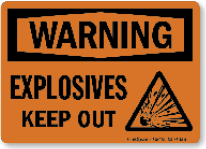Properly storing and securing explosives is vitally important in our industry. The federal Bureau of Alcohol, Tobacco and Fireams (ATF) released “Safety and Security Information for Federal Explosives Licensees and Permittees,” a free guide that contains security guidelines, tips, techniques and tools developed by ATF, The International Society of Explosives Engineers and The Institute of Makers of Explosives (IME).
Aggregates producers are urged to adopt a security program for explosives operations and storage sites. The following list is an example of the minimum general concepts IME recommends should be included in any security program.
- 1. Limit public disclosure of information on quantities and locations of explosives storage on a need-to-know basis. While you are required to notify the local fire authority of specific information regarding the quantities and location of explosives storage facilities, public safety authorities (such as police and local emergency management) also should be in possession of this information.
- 2. Get to know your local law enforcement and local emergency planning committee (LEPC) personnel, emergency responders and Joint Terrorism Task Force in your area and let them get to know you. An “open house” held every year at your facility is an excellent method to accomplish this. This not only provides first-hand familiarity of your site to law enforcement, it also provides invaluable face-to-face interaction with these authorities. If you cannot get law enforcement, LEPC personnel or emergency responders to visit your site, visit them and ask about emergency training opportunities. Request a meeting so that you can introduce and explain your operation. Specifically request in writing that law enforcement pay special attention to any suspicious activity around your site(s).
- 3. Employees are critical contributors to site security. Instruct all employees to report any unusual or suspicious activity immediately to appropriate authorities. Such activity could include:
- An attempt to purchase explosives by an unfamiliar or seemingly inexperienced individual.
An individual who is reluctant to provide identification or information on their operation or intended use of explosives.
Encountering an individual, either at work or on your own time, who seems very interested in your occupation and details related to the accessibility of explosives, blasting agents or precursor chemicals.
Out-of-place or repeat sightings of vehicles or individuals, especially those at gates or perimeter roads, and aerial over flights.
Sighting unauthorized individuals inside a secure area within the facility.
Explosives-laden vehicles being followed.
If you encounter any such activity, write down information such as vehicle color, make, license plate number and state, and a physical description of suspicious individuals. Take a photograph, if possible (send it to a company e-mail address where it can be saved and sent to authorities if necessary). Retain and preserve papers or other items a suspicious individual may have touched for potential law enforcement processing. When witnessing known criminal activity, contact law enforcement immediately.
- 4. Designate an individual as your security coordinator. All employees should report suspicious or unusual activities to the security coordinator or their immediate supervisor, if the security coordinator cannot be contacted. The security coordinator or supervisor then reports the activities to appropriate law enforcement personnel. The security coordinator should also establish relationships with nearby chemical operations or similar business to share information. The security coordinator should maintain a log of unusual events.
- 5. Establish a predetermined action plan for implementation of increased security measures brought on by a DHS National Terrorism Advisory System (NTAS) Alert. All employees should know how to deal with shipments, production, and blasting operations in progress. In the event of an NTAS Alert, additional security measures should be considered for implementation on a site-specific basis, in in response to the type and scope of the specific alert.
- 6. Disseminate increased security alerts and security recommendations to your customers and suppliers throughout the industry. Facilitate their understanding of these alerts and recommendations.
- 7. Control official documents and information. Prevent documents such as licenses, permits, route plans, shipping schedules, and other authorizations from reaching unauthorized individuals. Information related to shipping, inventory, production schedules, and processes should be kept secure and provided on a need-to-know basis.
- 8. Conduct a safety and security review of all outside contractors or service providers who have access to areas where explosives are present before their services are used and periodically thereafter. Include a security element in contractor or service provider training.
- 9. Develop security plans and conduct vulnerability assessments for your entire operation.

